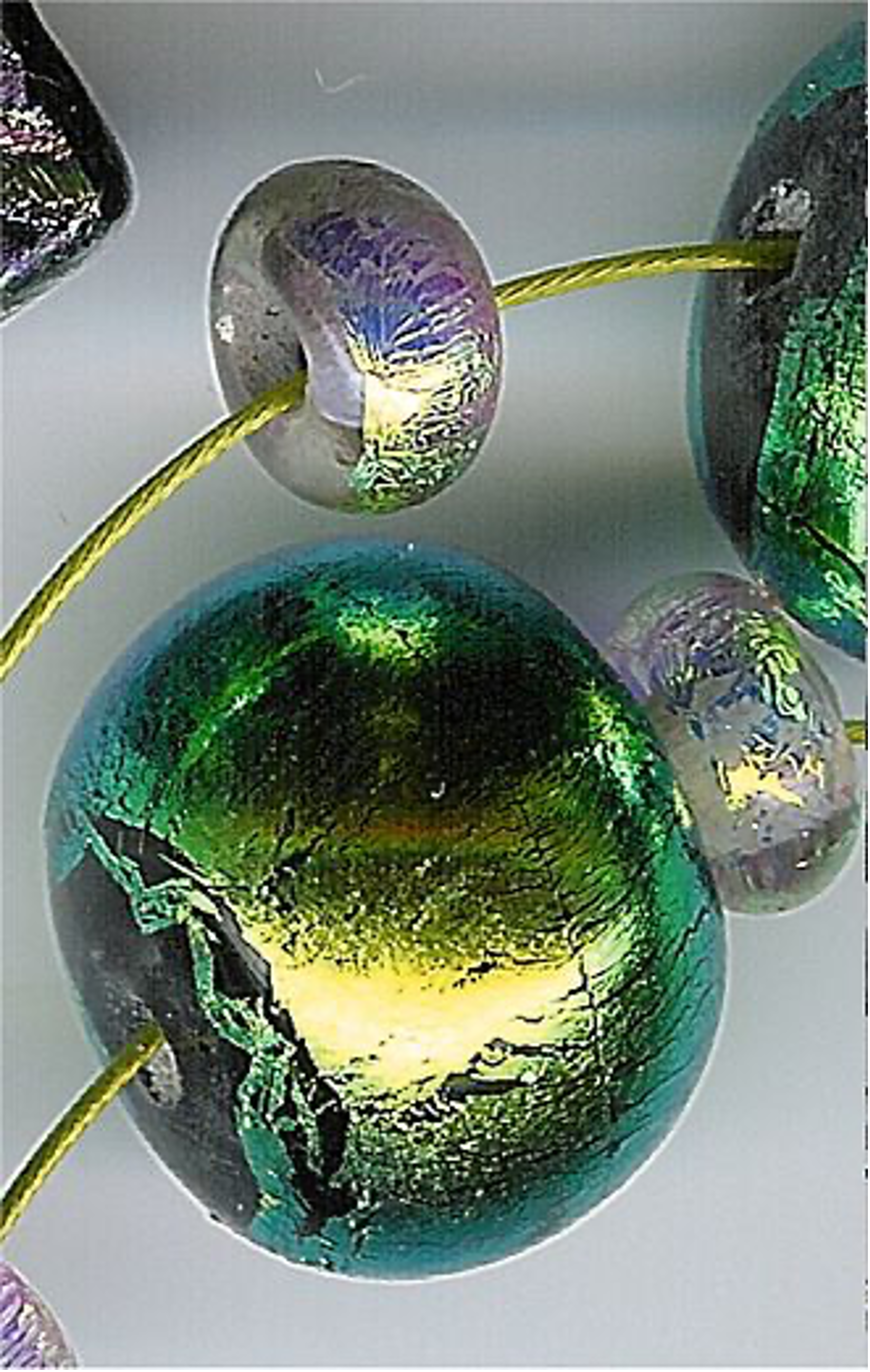Timbral Progression in Rebecca Saunders’ dichroic seventeen
EN | FR
Timbral Progression
in Rebecca Saunders’ dichroic seventeen
Amazing Moments in Timbre | Timbre and Orchestration Writings
by Matthew Ludwig
Dichroism
Dichroism is the property of showing two colours or of exhibiting different colours when viewed from different angles and is an attribute of some crystals, minerals, and solutions. This property results when a material absorbs wavelengths of light differently depending on their direction of incidence. [1] This phenomenon is apparent in the dichroic beads and the three identical dichroic filters shown in Figures 1 and 2 below.
Figures 1: Dichroic beads.
Figure 2: Dichroic filters.
Bright and Dark Timbres
Inspired by this phenomenon, Rebecca Saunders’ dichroic seventeen (1998) for accordion, electric guitar, pianoforte, percussion, violincello and double bass uses several orchestration techniques to produce a timbral progression between darker and brighter timbres in order to emulate dichroism. Generally, when discussing timbre, terms such as brightness, darkness and roughness which are traditionally associated with visual or tactile modalities are frequently employed to describe music. For instance, a specific timbre is characterized as dark when there is more energy in the sound’s lower partials and bright when there is more energy in the sound’s higher partials (see the Timbre Lingo post “Brightness / Darkness” for more details).
A Timbral Progression
This is apparent in the passage shown below in Figure 3, which illustrates a timbral progression in which Saunders quickly moves between light and dark timbres. In mm. 32, the violincello and two contrabasses have double stops with a low G and quarter and eighth-tone adjustments of a low F# which gives rise to a dark timbre or colour. This event is highlighted in dark blue in Figure 3 below. Following this, Saunders creates a timbral progression away from this darker timbre toward a brighter timbre by successively introducing brighter timbres in the electric guitar, percussion, and accordion. These brighter timbres are highlighted in yellow in Figure 3 below. In addition, Saunders also writes a crescendo and accelerando which makes the electric guitar, percussion, and accordion more prominent and further brightens the ensemble’s overall timbre. During this process, the violincello and contrabass are notated an octave higher and indicated to play sul ponticello and flautando. In the explanatory notes to the work, Saunders writes that when the strings play sul ponticello and pp, that the overtones should dominate the sound. As a result, the contrabass G in mm. 36 has a bright timbre which is highlighted in light blue in Figure 3 below and marked with SP flaut. Then there is a high C# in the accordion and a G in the violincello marked Sul ponticello in mm. 38. This is the brightest moment and the climax of the timbral progression and is indicated by the red boxes in Figure 3 below. The entire timbral progression can be heard in the Audio Example 1 below.
Audio Example 1: 3: Saunders, dichroic seventeen, 1:47–2:18. A timbral progression from darker to brighter timbres. Source
Figure 3: Saunders, dichroic seventeen, mm. 32–43. A timbral progression from darker to brighter timbres.
Saunders’ use of timbre throughout this passage is suggestive of both definitions of the concept of dichroism that are suggested in the composer’s note: that of a material showing two colours and that of a material showing different colours when viewed from different angles or in different circumstances.[2] The way in which the ensemble takes on two clearly contrasting bright and dark timbres in a short period of time is suggestive of first definition. Furthermore, the ways in which Saunders initially introduces the violincello on a dark timbre, uses a timbral progression to brighten the ensemble’s overall timbre, subsequently shifts the violincello line up an octave, and uses sul ponticello to suddenly brighten the violincello’s timbre is suggestive of the second definition of dichroism, as the violincello’s timbre changes when it is heard in a different context.
Conclusion
The use of various orchestration techniques to produce a timbral progression in order to evoke the concept of dichroism in her work dichroic seventeen is also reflective of her larger fascination with colour and its various shades. This theme is apparent in the titles of her other works which include Caerulean, White, Shadow, Blue and Gray and the underside of green. Ultimately, Saunders’ dichroic seventeen provides yet another example of how timbre has been used to emulate visual phenomena in music and how the use of timbre to create cross-modal correspondences can give rise to fascinating musical works.
REFERENCE LIST
“Dichroism”. 2022. Oxford English Dictionary, updated March 2022. https://www.oed.com/view/Entry/52239?redirectedFrom=dichroism&
Pschemp, January 27th, 2006. Dichroicclose.jpg. Wikipedia. https://en.wikipedia.org/wiki/Dichroism#/media/File:Dichroicclose.jpg
Masur, January 18th, 2007. Dichroic_filters.jpg. Wikipedia. https://en.wikipedia.org/wiki/Dichroic_filter#/media/File:Dichroic_filters.jpg
Saunders, Rebecca. 1998. "dichroic seventeen". https://www.rebeccasaunders.net/dichroic-seventeen.
Saunders, Rebecca. 1998. “dichroic seventeen”. SoundCloud. https://soundcloud.com/rebeccasaunders/dichroic-seventeen
Saunders, Rebecca. “dichroic seventeen”: Edition Peters, 1998. https://issuu.com/editionpeters/docs/ep_7525__rebecca_saunders__dichroic_c50e3bfee5851b

